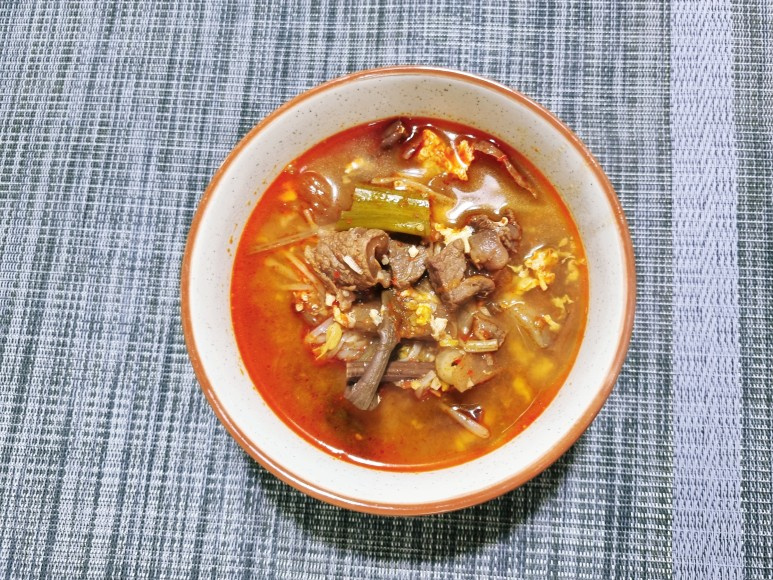Spicy Yukgaejang: A Hearty Korean Beef and Vegetable Soup
Reviving Leftover Ferns into a Delicious Yukgaejang Stew

Enjoy a satisfyingly spicy Yukgaejang anytime! This special recipe uses frozen gosari (fernbrake) and toran-dae (taro stems) to create a deep and rich flavor. With generous ingredients and a simple cooking process, anyone can make delicious Yukgaejang.
Main Yukgaejang Ingredients- 200g Cooked Fernbrake (gosari), cut into bite-sized pieces
- 200g Cooked Taro Stems (toran-dae), cut into bite-sized pieces
- 1 bag Bean Sprouts (wash thoroughly and drain)
- 2 Large Green Onions, cut into large pieces
- 300g Beef for Stew (cut into bite-sized pieces)
- 2 Cheongyang Peppers (adjust to taste, slice diagonally)
- 1/2 Onion, thinly sliced
- Glass Noodles (for serving, soak in lukewarm water beforehand)
Seasoning and Additional Ingredients- 2 Tbsp Perilla Oil
- 1 tsp Minced Garlic (for sautéing)
- 2 Tbsp Soup Soy Sauce (Guk-ganjang)
- 5 Tbsp Red Pepper Flakes (Gochugaru, adjust spice level)
- 2 Tbsp Fish Sauce (for umami)
- 2 Tbsp Soy Sauce (Jin-ganjang)
- 1 Tbsp Cooking Syrup (adjust sweetness)
- 1 tsp Dashida (MSG-based soup stock, for enhanced flavor)
- Pinch of Black Pepper
- 2 Eggs, lightly beaten
- Salt (to taste)
- Water (plenty)
- 2 Tbsp Perilla Oil
- 1 tsp Minced Garlic (for sautéing)
- 2 Tbsp Soup Soy Sauce (Guk-ganjang)
- 5 Tbsp Red Pepper Flakes (Gochugaru, adjust spice level)
- 2 Tbsp Fish Sauce (for umami)
- 2 Tbsp Soy Sauce (Jin-ganjang)
- 1 Tbsp Cooking Syrup (adjust sweetness)
- 1 tsp Dashida (MSG-based soup stock, for enhanced flavor)
- Pinch of Black Pepper
- 2 Eggs, lightly beaten
- Salt (to taste)
- Water (plenty)
Cooking Instructions
Step 1
Cut the cooked gosari and toran-dae into long strips, about 1 to 1.5 cm wide. Cutting them too short might cause them to break apart during cooking, so maintain a suitable length.

Step 2
Prepare about 300g of beef for stew, cutting it into bite-sized pieces. Slightly draining the blood from the beef will result in a cleaner broth.

Step 3
Rinse the bean sprouts thoroughly under running water and drain them. Rinsing them for too long can impart a raw smell, so a quick rinse is sufficient.

Step 4
In a large bowl, combine the cut gosari and toran-dae. Add 5 Tbsp gochugaru, 2 Tbsp soup soy sauce, 2 Tbsp fish sauce, 2 Tbsp soy sauce, 1 Tbsp cooking syrup, 1 tsp Dashida, a pinch of black pepper, and 1 Tbsp minced garlic. Gently mix everything with your hands until well combined. Let it marinate for about 10 minutes for the flavors to meld.

Step 5
Heat 2 Tbsp perilla oil in a deep pot over medium heat. Add 1 tsp minced garlic and sauté until fragrant. Then, add the prepared beef and stir-fry until the surface is browned.

Step 6
Once the beef is browned, add the marinated gosari and toran-dae to the pot. Stir-fry together for about 5 minutes, allowing the ingredients and seasonings to meld and deepen in flavor.

Step 7
Pour enough water into the pot to generously cover the ingredients. Bring to a boil over high heat. Adjust the amount of water according to your desired broth consistency.

Step 8
Slice the onion thinly and cut the green onions into large pieces to add flavor to the Yukgaejang. Slice the Cheongyang peppers diagonally (removing seeds if you prefer less heat) for a spicy kick.

Step 9
For the accompanying glass noodles, soak them in lukewarm water for at least 30 minutes until softened. Pre-soaking will shorten the cooking time later.

Step 10
Once the soup comes to a boil, skim off any foam that rises to the surface using a ladle. This step ensures a clear and clean broth without any unpleasant odors.

Step 11
Reduce the heat to medium and let the soup simmer, partially covered, for about 20-30 minutes. Simmering patiently is key for the ingredients to cook through and the flavors to develop deeply.

Step 12
In a separate small bowl, crack 2 eggs and lightly beat them. Beating the eggs beforehand allows for a smooth texture when added to the soup.

Step 13
Taste the simmering Yukgaejang and add salt to adjust the seasoning if needed. It’s best to season gradually rather than making it too salty from the start.

Step 14
Add the prepared bean sprouts and cook until they are just tender. Avoid overcooking the bean sprouts, as they can become mushy; aim for a slightly crisp texture.

Step 15
Next, add the sliced onions and diagonally sliced peppers, and simmer for another 2-3 minutes. This allows the natural sweetness of the onions and the spice of the peppers to infuse into the broth.

Step 16
Finally, add the large green onions and simmer for a short while longer. The fresh flavor of the green onions complements the Yukgaejang broth beautifully.

Step 17
Slowly pour the beaten eggs in a circular motion around the edges of the pot. The trick is to let the egg cook without stirring, allowing it to form delicate ribbons.

Step 18
Let the egg cook until it sets into soft curds without stirring. It’s best to do this over medium-low heat to prevent the egg from burning and to ensure it cooks evenly.

Step 19
Your hearty and spicy Yukgaejang is complete! Serve hot, perhaps with the soaked glass noodles, and enjoy this comforting Korean classic.




